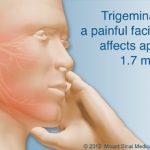Guest post by Joshua B. Bederson, MD, Professor and Chair of the Department of Neurosurgery at Mount Sinai Health System and specialist in Trigeminal Neuralgia. To make an appointment with Dr. Bederson, call 212-241-2377.
Trigeminal Neuralgia is a disorder with episodes of severe, stabbing, electric shock-like pain in the face as the result of a blood vessel or other lesion coming in contact with the trigeminal nerve. Contact with the trigeminal nerve causes excruciating pain on that side of the face, most commonly in the lower face and jaw, although it sometimes may occur around the nose and above the eye.
Trigeminal pain may be cause by very common activities, including shaving, applying make-up, washing your face, brushing your teeth, chewing, drinking, laughing, talking, and sometimes simply breathing. Intense flashes of pain may also be triggered by simply touching the cheek, feeling a vibration, or even a breeze or heat and cold.
Individual episodes can last for seconds, minutes, hours or longer, and frequently come in groups over several days, weeks or months, then may disappear for months or years. The attacks often worsen over time, with fewer and shorter pain-free periods before they recur.
Trigeminal neuralgia occurs most often in people over age 50, but it can occur at any age and is more common in women than in men.
The Intense pain from Trigeminal neuralgia can be incapacitating. Typical pain medicines like acetaminophen, Ibuprofen, and narcotics do not usually work. Many patients require anticonvulsant drugs; however, these may become ineffective overtime and can have debilitating side effects.
Through a thorough neurological examination and MRI scan we can determine the cause of facial pain and offer a curative surgery.
Numerous procedures have been developed to treat TGN, and these procedures can be divided into “Ablative” (destructive) and “Nonablative” techniques. The ablative techniques include stereotactic radiosurgery such as Gamma Knife, Radiofrequency lesions, and other percutaneous techniques These all have the advantage of being minimally invasive but the disadvantage of destroying portions of the nerve.
Microvascular Decompression
Microvascular decompression (MVD), performed under general anesthesia, is a non-ablative technique that leaves the trigeminal nerve intact. MVD addresses the primary cause of trigeminal neuralgia, vascular compression. A small opening is made behind the ear on the side with the pain. The trigeminal nerve is viewed with a microscope and the compressing blood vessels are moved away from the nerve. The cause of pain is addressed by carefully displacing the compressing artery or vein away from the nerve and protecting the nerve with a soft pad (typically shredded Teflon) or sponge to prevent recurrence.
In appropriately selected patients MVD is highly effective with a very low complication rate of the procedure and a low recurrence rate for pain. Here at Mount Sinai, we have excellent success rates using MVD on carefully selected patients. Experience has shown that prognosis after MVD is best in patients who meet the following criteria:
- Your pain is on one side of the face only.
- You experienced an initial response to anticonvulsant medical therapy.
- Your pain follows the pathway of the trigeminal nerve.
- Your pain is episodic rather than constant.
Even if your profile does not exactly match the above, you may still have an excellent response to microvascular decompression, depending on the findings.
We Can Help
If you have been diagnosed with trigeminal neuralgia or are experiencing symptoms, please call Dr. Joshua Bederson at 212-241-2377 to schedule an appointment.


This post is worth everyone’s attention. Where can I find out more?